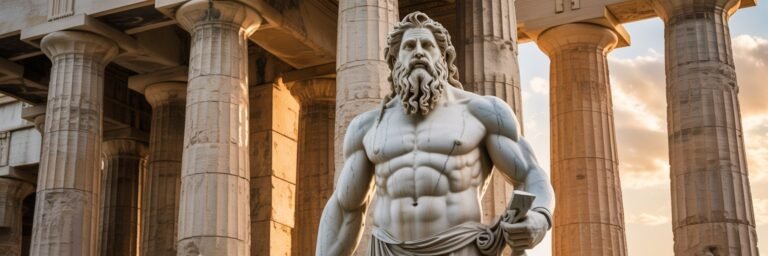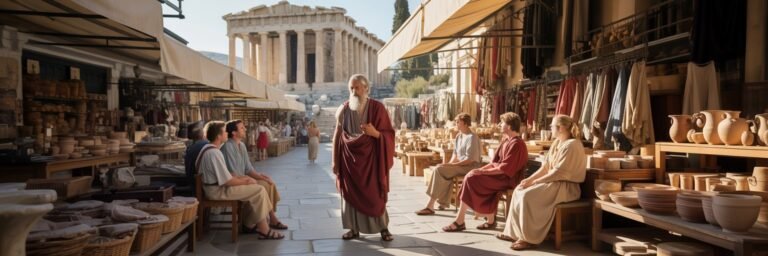INTRODUCTION
The story of Classical Greek art and architecture is a tale as old as Western civilization itself. It’s the story of a culture passionately devoted to beauty, harmony, and the human individual’s potential. A society that dared to envision mankind as capable of god-like grandeur. And it’s the narrative of a civilization whose fundamental values continue to inform the Western world today. The Classical era (5th – 4th century BCE), noted for unparalleled creativity and technical innovation, produced masterpieces in sculpture, pottery, and architecture. The purpose of this article is to delve into the historical background, theories, interpretations, mysteries, controversies, and the symbolism of this era’s artistic prowess, its modern investigations, and the cultural legacy it has bequeathed to posterity.
HISTORICAL BACKGROUND
The Classical era was a golden age in Greece. This period was characterized by profound political, philosophical, and cultural advancements. It was the era of Socrates, Plato, Euclid, Hippocrates, and many other significant figures which left an indelible mark on Western civilization. It was also the time when the city-states of Athens and Sparta dominated the Hellenic world. The Persian Wars (499–449 BCE) bolstered a sense of cultural identity among the Greeks, fostering a shared aesthetic idealism which would reach its zenith during the Classical era.
In the realm of art, this age was dominated by Athens, the cultural capital of Greece. Athenian artists and architects pioneered new techniques and styles, driven by a culture that prized beauty and valued creative endeavor.
THEORIES AND INTERPRETATIONS
The art and architecture of Classical Greece are often seen as the physical embodiment of a culture’s ideals. This period’s creativity is often interpreted through two main intellectual lenses: Philosophical Harmonicism and Humanistic Idealism. These guiding principles drove innovation while maintaining a reverence for tradition.
Philosophical Harmonicism is the belief in the intrinsic value of proportionality and harmony in the physical world, reflected in the meticulously proportional designs of Greek architecture—such as the Parthenon—with its sophisticated mathematical ratios and precision.
Humanistic Idealism underpinned the Greek fascination with the human form. Greek statues portrayed humans in their most idealized form, in the belief that the pursuit of individual excellence would lead to a society’s advancement. Examples abound in Classical Greek sculpture, including the Discobolus of Myron and Praxiteles’ Hermes.
MYSTERIES AND CONTROVERSIES
Despite our intimate knowledge of Classical Greek culture, mysteries and controversies persist. The Parthenon, despite its architectural splendor and political symbolism, holds a significant mystery: the missing Parthenon Marbles. These sculptures, removed in the early 19th century by British diplomat Lord Elgin, are currently housed in the British Museum. Their removal and subsequent possession has ignited a long-lasting controversy concerning their rightful owner.
Moreover, the very interpretation of Classical architecture is subject to intense debate. Did the Greeks really see their marble temples as we do—grand white edifices—or were they vividly colored? Both the White Marble Theory and the Polychromy Theory have their ardent supporters, with the latter gaining momentum after trace pigments were found on ancient ruins.
SYMBOLISM AND CULTURAL SIGNIFICANCE
Classical Greek art and architecture are laden with symbolism and cultural significance. The Parthenon, for instance, is both a dedication to the goddess Athena and a commemoration of Athenian civic pride and victory over the Persians. The sculpture often represented beauty, strength, and virtue, as seen in Discobolus’ toned physique or Nike’s forward charging motion, signifying victory. The themes of tragedy and comedy—commonly revered in Greek theater—also found their way into the artistic narrative of this era, underscoring the Greeks’ understanding of the human condition.
MODERN INVESTIGATIONS
Modern scientific and archaeological discoveries continue to unearth new insights into the aesthetic brilliance of the Classical Greeks. Advanced technologies, such as spectral imaging and 3D reconstruction, have been used to uncover evidence of polychromy, deeply embedded within the structural remnants of Greek architectural masterpieces. Similarly, institutions like the Acropolis Museum in Athens are constantly working to restore and preserve the relics of this period.
LEGACY AND CONCLUSION
The legacy of Classical Greek art and architecture is profound, permeating every aspect of Western culture from the academic curriculum to contemporary architectural design. The Roman Empire, the Renaissance, and even contemporary American government buildings owe a great deal to the aesthetics of the Classical Greeks. Their focus on individualism, human potential, and harmony continues to resonate with modern societies.
In conclusion, the art and architecture of Classical Greece are arguably the epitome of human creativity, intellectual growth, and artistic expression. These enduring legacies serve as continual reminders of a civilization that held the belief that “Man is the measure of all things” – a sentiment that resonates through the ages and stands as a testament to the timelessness of the Greek artistic spirit. The study and appreciation of this monumental period in history is not merely an academic pursuit— it is a journey of the human spirit in its ceaseless quest for beauty, harmony, and meaning.





